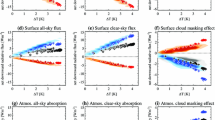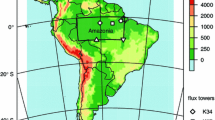Abstract
An infrared radiation parameterization has been applied to a detailed three-dimensional mesoscale model in order to determine whether radiative forcing significantly affects mesoscale atmospheric processes. By taking into account water vapor, liquid water, and carbon dioxide absorption, the scheme differentiates between cloud and clear air regions. The parametric model is presented, along with an overview of the associated mesoscale model.
Comparisons between a control run in which only a uniform cooling rate of l K day−1 is specified, and runs with the infrared scheme are made for 12-hr simulations. The major feature of the radiative forcing is seen to be strong cloud-top cooling. This leads to enhanced destabilization of the upper cloud layer, which in turn results in faster growth of clouds (and which extend to higher levels) than in the control experiment. The deeper clouds force a more vigorous secondary circulation, in which thermodynamic feedbacks between clouds and their environment are substantially stronger than in the case with only a constant cooling rate. This confirms findings made in previous studies undertaken in small-scale numerical models. The discussion also focuses upon a simulation in which the cloud-top infrared cooling has been smoothed out over neighboring vertical levels, in order to represent a cloud-top height distribution crudely. The results indicate that although the absolute values of cloud-top cooling are reduced with respect to the unfiltered case, the fact that cooling extends even higher than previously predicted leads to the formation of thicker, more vigorous clouds. These clouds interact more intensely with their environment than in the unfiltered situation, thereby considerably modifying the mesoscale atmosphere.
Similar content being viewed by others
References
Augstein, E. and Wendel, W.: 1981, ‘Modelling of the Time-Dependent Atmospheric Tradewind Boundary Layer with Non-precipitating Clouds’, Contr. Atmos. Phys. 53, 509–538.
Beniston, M. G.: 1982, ‘Développement d'un modèle tridimensionnel à méso échelle pour l'étude de la convection cellulaire’, La Météorologie 29, 193–200.
Beniston, M. G.: 1983, ‘Mesoscale Model for the Investigation of Three-Dimensional Convective Phenomena. Model Description and Preliminary Results from a KonTur Simulation’, Hamburg. Geophys. Einzelschr. B2, 1–62.
Beniston, M. G.: 1984, ‘A Numerical Study of Atmospheric Mesoscale Cellular Convection’, Dynamics of Atmospheres and Oceans, (in press).
Betts, A. K.: 1975, ‘Parametric Interpretation of Trade-Wind Cumulus Budget Studies’, J. Atmos. Sci. 32, 1934–1945.
Businger, J. A., Wyngaard, J. C., Izumi, Y., and Bradley, E. F.: 1971, ‘Flux-Profile Relationships in the Atmospheric Surface Layer’, J. Atmos. Sci. 28, 181–189.
Chen, C. and Cotton, W. R.: 1983, ‘A One-Dimensional Simulation of the Stratocumulus-Capped Mixed Layer’, Boundary-Layer Meteorol. 25, 289–321.
Deardorff, J. W.: 1980, ‘Stratocumulus-Capped Mixed Layers Derived from a Three-Dimensional Model’, Boundary-Layer Meteorol. 18, 495–527.
Fravalo, C., Fouquart, Y., and Rosset, R.: 1981, ‘The Sensitivity of a Model of Low Stratiform Clouds to Radiation’, J. Atmos. Sci. 38, 1049–1062.
Hense, A., Kerschgens, M., and Raschke, E.: 1982, ‘An Economical Method for Computing the Radiative Energy Transfer in Circulation Models’, Quart. J. Roy. Meteorol. Soc. 108, 231–252.
Hoeber, H.: 1982, ‘KonTur Field Phase Report’, Hamburg. Geophys. Einzelschr., Reihe B, Nr. 1.
Kessler, E.: 1969, ‘On the Distribution and Continuity of Water Substance in Atmospheric Circulations’, Meteor. Mon. Am. Meteorol. Soc. 10, 1–84.
Kondratyev, K. Ya.: 1969, Radiation in the Atmosphere, Academic Press, New York, London, 912 pp.
O'Brien, J. J.: 1970, ‘A Note on the Vertical Structure of the Eddy Exchange Coefficient in the Planetary Boundary Layer’, J. Atmos. Sci. 27, 1213–1215.
Platt, C. M. R.: 1976, ‘Infrared Absorption and Liquid Water Content in Stratocumulus Clouds’, Quart. J. Roy. Meteorol. Soc. 102, 553–562.
Rodgers, C. D.: 1967, ‘The Use of Emissivity in Atmospheric Radiation Circulations’, Quart. J. Roy. Meteorol. Soc. 93, 43–54.
Schaller, E. and Kraus, H.: 1981, ‘The Role of Radiation in an Inversion-Capped Boundary Layer. Part I: The Need for a Detailed Consideration of Radiative Processes’, Boundary-Layer Meteorol. 20, 485–495.
Schmetz, J. and Raschke, E.: 1981, ‘An Approximate Computation of Infrared Radiative Fluxes in a Cloudy Atmosphere’, Pure Appl. Geophys. 119, 248–258.
Schmetz, J., Raschke, E., and Fimpel, H.: 1981, ‘Solar and Thermal Radiation in Maritime Stratocumulus Clouds’, Contr. Atmos. Phys. 54, 442–452.
Sommeria, G.: 1976, ‘Three-Dimensional Simulation of Turbulent Processes in an Undisturbed Trade Wind Boundary Layer’, J. Atmos. Sci. 33, 216–241.
Stearns, L. P.: 1983, ‘Infrared Cooling in Cloudy Atmospheres: Precision of Grid Section for Numerical Models’, Monthly Weather Rev. 111, 1501–1505.
Stephens, G. L. and Webster, P. J.: 1979, ‘Sensitivity of Radiative Forcing for Variable Cloud and Moisture’, J. Atmos. Sci. 36, 1542–1556.
Stephens, G. L. and Wilson, K. J.: 1980, ‘The Response of a Deep Cumulus Convection Model to Changes in Radiative Heating’, J. Atmos. Sci. 37, 421–434.
Veyre, Ph., Sommeria, G., and Fouquart, Y.: 1982, ‘Attempt to Directly Simulate Cloud-Radiation Interaction in the Case of Small Cumuli’, in E. M. Agee and T. Asai (eds.), Cloud Dynamics. D. Reidel Publ. Co., Dordrecht, Holland, pp. 135–147.
Warner, J.: 1977, ‘Time Variation of Updraft and Water-Content in Small Cumulus Clouds’, J. Atmos. Sci. 34, 1306–1313.
Yanai, M., Esbensen, S., and Chu, J. M.: 1973, ‘Determination of Bulk Properties of Tropical Cloud Clusters from Large-Scale Heat and Moisture Budgets’, J. Atmos. Sci. 30, 611–627.
Author information
Authors and Affiliations
Rights and permissions
About this article
Cite this article
Beniston, M., Schmetz, J. A three-dimensional study of mesoscale model response to radiative forcing. Boundary-Layer Meteorol 31, 149–175 (1985). https://doi.org/10.1007/BF00121175
Accepted:
Issue Date:
DOI: https://doi.org/10.1007/BF00121175




